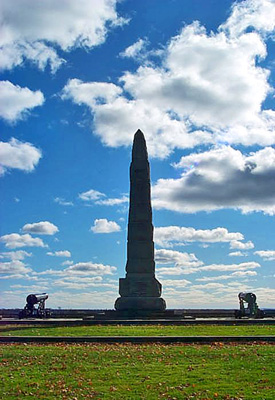Battle of Crysler's Farm National Historic Site of Canada
Morrisburg, Ontario

commemorative monument
© Parks Canada Agency / Agence Parcs Canada, Dan Pagé, 2008.
Address :
Morrisburg, Ontario
Recognition Statute:
Historic Sites and Monuments Act (R.S.C., 1985, c. H-4)
Designation Date:
1920-01-30
Dates:
-
1813 to 1813
(Significant)
Event, Person, Organization:
-
War of 1812
(Event)
-
Major-General James Wilkinson
(Person)
-
Lieutenant-Colonel Joseph Morrison
(Person)
-
John Crysler
(Person)
Other Name(s):
-
Battle of Crysler's Farm
(Designation Name)
Research Report Number:
2009-CED/SDC-002
Plaque(s)
Existing plaque: 13740 County Road 2, Morrisburg, Ontario
Here, on the farm of John Crysler, was fought one of the decisive battles of the War of 1812. On 11 November 1813 Lieutenant-Colonel Joseph Morrison, with 800 British and Canadian regulars, militia, and Indians, engaged an American force of 4,000 under Brigadier-General John Boyd. The open terrain was suited to the training of the well-drilled British regulars who, after two hours of heavy fighting, routed the enemy. This victory ended a major American thrust at Montreal.
*Note: This designation has been identified for review. A review can be triggered for one of the following reasons - outdated language or terminology, absence of a significant layer of history, factual errors, controversial beliefs and behaviour, or significant new knowledge.
Description of Historic Place
Battle of Crysler’s Farm National Historic Site of Canada is located in Crysler’s Farm Battlefield Park, near Upper Canada Village, east of Morrisburg, Ontario. The battle, which took place on November 11, 1813 on farmland belonging to John Crysler, ended the American campaign for Montréal. While the original battlefield is now underwater, a grassy knoll made from earth removed from the original site and a commemorative monument consisting of an obelisk surrounded by a rectangle of flagstones and two flanking guns on garrison carriages together comprise the historic site. Official recognition refers to the monument site covering approximately 0.1 hectares bordered by a low fieldstone wall on the east, west and south sides and a concrete edge on the north.
Heritage Value
Battle of Crysler’s Farm was designated a national historic site of Canada in 1920. It is designated because: on the farm of John Crysler, 11 November 1813, was fought one of the decisive battles of the War of 1812.
The heritage value of the Battle of Crysler’s Farm resides in its historical associations with the armed conflict related to the American campaign for Montréal in 1813. On November 10, 1813, 8,000 American troops under the leadership of Major-General James Wilkinson arrived in the town of Williamsburg, Ontario. Simultaneously, 800 British troops under Lieutenant-Colonel Joseph Morrison, took position on John Crysler’s farm behind two large ravines. The British had pursued the Americans down the St. Lawrence River and were under orders to slow the American advance and prevent a surprise attack. On November 11, the Americans launched an attack with only half of their troops. Wilkinson believed that the British were more inexperienced and underestimated their size as half of the British troops were wearing grey winter coats over the typical red coat. Without a tactical plan, the Americans suffered heavy casualties and were driven back to Cornwall. The heavy losses and quick retreat at the Battle of Crysler’s Farm ended the American campaign for Montréal.
In 1895, the Department of Militia and Defence erected a monument on the battlefield of Crysler’s Farm. Following the First World War in 1921, the Historic Sites and Monuments Board of Canada (HSMBC) erected a plaque on the existing monument. With the construction of the St. Lawrence Seaway, the original location of the battle was flooded and the monument was relocated to its current location in Crysler’s Farm Battlefield Park in 1955. The monument now rests on a stepped base supported by a rectangle of flagstones, atop a mound of earth from the original battlefield.
Sources: Historic Sites and Monuments Board of Canada, Minutes, May 1953; October 1966; March 2009.
Character-Defining Elements
Key elements that contribute to the heritage value of this site include: its location in Crysler’s Farm Battlefield Park near Upper Canada Village, east of Morrisburg Ontario; its setting on a grassy knoll made from earth removed from the original monument site, and bordered by a low fieldstone wall; the HSMBC plaque and commemorative monument consisting of a granite obelisk on a stepped base, surrounded by a rectangle of flagstones and two flanking guns on garrison carriages; its proximity to the original Crysler’s Farm battle site, most of which lies underwater; viewscapes from the site across a grassy landscape to the St. Lawrence Seaway.